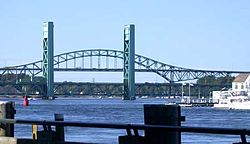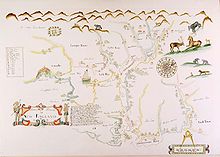Piscataqua River
| Piscataqua River Pskehtekwis[citation needed] | |
|---|---|
 Piscataqua River fromPortsmouth, New Hampshire,with the formerSarah Mildred Long Bridgeand thePiscataqua River Bridge(background) | |
| Location | |
| Country | United States |
| State | New Hampshire,Maine |
| Physical characteristics | |
| Source | CochechoandSalmon Fallsrivers |
| • location | New Hampshire/Maineborder,United States |
| • coordinates | 43°10′34″N70°49′29″W/ 43.17611°N 70.82472°W |
| • elevation | 0 ft (0 m) |
| Mouth | Atlantic Ocean |
• location | Portsmouth Harbor,New Hampshire/Maineborder,United States |
• coordinates | 43°3′22″N70°42′11″W/ 43.05611°N 70.70306°W |
• elevation | 0 ft (0 m) |
| Length | 12 mi (19 km) |
| Basin features | |
| Tributaries | |
| • left | Salmon Falls River |
| • right | Cochecho River,Great Bay |
ThePiscataqua River(Abenaki:Pskehtekwis) is a 12-mile-long (19 km)tidal riverforming the boundary of the U.S. states ofNew HampshireandMainefrom its origin at the confluence of theSalmon Falls RiverandCochecho Riverto the Atlantic Ocean. Thedrainage basinof the river is approximately 1,495 square miles (3,870 km2), including the subwatersheds of theGreat Works Riverand the five rivers flowing intoGreat Bay:theBellamy,Oyster,Lamprey,Squamscott,andWinnicut.
The river runs southeastward, with New Hampshire to the south and west and Maine to the north and east, and empties into theGulf of Maineeast ofPortsmouth, New Hampshire.The last 6 miles (10 km) before the sea are known asPortsmouth Harborand have a tidal current of around 4 knots (7.4 km/h; 4.6 mph).[1]The cities/towns of Portsmouth,New Castle,Newington,KitteryandEliothave developed around the harbor.[2]
History[edit]



Named by the area's originalAbenakiinhabitants, the wordPiscataquais believed to be a combination ofpeske(branch) withtegwe(a river with a strong current, possibly tidal).[3]The first knownEuropeanto explore the river wasMartin Pringin 1603. CaptainJohn Smithplaced a spelling similar to "Piscataqua" for the region on his map of 1614. The river was the site of the firstsawmillin the colonies in 1623, the same year the contemporary spelling "Piscataqua" was first recorded.
Once salmon, sturgeon, oysters, clams, scallops, lobsters, mussels, eels, seals, and many others species of marine life were common in the river, evidenced by such tributaries as theSalmon Falls River,Sturgeon Creek and Seal Rock inEliot, Maine,theOyster RiverinDurham, New Hampshire,and theLamprey RiverinNewmarket, New Hampshire.All but the salmon and sturgeon remain, with fishing forstriped bassandbluefishcommon recreational sports.
In the mid 1630s some of the region's earliest European settlers built a sawmill in what is today'sBerwick, Maine,on a tributary above the head of tide of the Piscataqua.[4]Thought to be the first over-shot water-powered site in America,[5][6]it became known as the "Great Works", giving name to today'sGreat Works River.
After the Allies' European victory in theSecond World War,four surrendered GermanU-boatstraveled upriver to thePortsmouth Naval Shipyard,[7]with their captains and crews interned asPOWs[8]atPortsmouth Naval Prison.[9]U-805was the first to arrive, towed up the river to a rendezvous with U.S. officials on a tugboat off the Navy Yard on May 15, 1945.U-873andU-1228arrived the next day.
U-234,by far the greatest prize, arrived on May 19, seized offNova Scotiaby the U.S. destroyer escortSutton.It had left Germany with a cargo bound for Japan of a disassembledMesserschmitt Me 262jet plane, the most sophisticated fighter of World War II; two top Japanese scientists; and two high-ranking Nazi officers. While this was enough to create a media sensation, it was decades later before the U.S. government revealed that the sub also carried a top secret load ofuranium oxideproduced by the German atomic weapons program bound for a last-ditch Japanese effort. Instead, the extremely valuable nuclear material was diverted to the U.S.' top secretManhattan Project,and ended up part of the bomb the U.S. Army Air Corps dropped overHiroshimato hasten the end of the Pacific war.[9]
The shipyard is located onSeavey's IslandinKittery, Mainenear the Piscataqua's mouth. Long regarded by some as being in New Hampshire, the yard was claimed by that state into the 2000s. However, thePiscataqua River border disputeover Seavey's Island was settled by a 2001U.S. Supreme Courtdecision which cited a 1977 decision affirming New Hampshire's claim that the state borders met at the center of the river's navigable channel as described in a 1740 decree, thus placing the island in Maine.[10]
Estuary[edit]
The Piscataqua River and its tributaries, includingGreat Bay,form a substantialestuarine environment.Two rivers, theSalmon FallsandCochecho,join to form the Piscataqua on the eastern edge ofDover, New Hampshire,at the northwest corner ofEliot, Maine.Five rivers with tidal stretches flow intoGreat Bay:theBellamy,Oyster,Lamprey,Squamscott,andWinnicut,and theGreat Works Riverdrains into the tidal portion of the Salmon Falls.
See also[edit]

- Badger's Island
- Great Bay (New Hampshire)
- Little Bay Bridge
- List of rivers of Maine
- List of rivers of New Hampshire
- Memorial Bridge (Portsmouth, New Hampshire)
- Piscataqua River Bridge
- Point of Graves Burial Ground
- Prescott Park (New Hampshire)
- Sarah Mildred Long Bridge
External links[edit]
- MaineRivers.orgPiscataqua River
- History as Border of New Hampshire
- Seacoast Forts of Portsmouth Harborfrom American Forts Network
- Port of New Hampshire
References[edit]
- ^NOAA "Tides & Currents fact sheet" - "Nobles Island, north of"
- ^DeLorme Mapping CompanyThe Maine Atlas and Gazetteer(13th edition) (1988)ISBN0-89933-035-5map 1
- ^Derivation ofPiscataqua.
- ^Palmer, Ansell W., ed.Piscataqua Pioneers: Selected Biographies of Early Settlers in Northern New England,pp. 67, 116-7, Piscataqua Pioneers, Portsmouth, New Hampshire, 2000.ISBN0-9676579-0-3.
- ^Old Berwick Historical Society "William Chadbourne (b. 1582), Pioneer Millwright of 1634: Great Works,"
- ^Bacon, Elaine C.The Chadbourne Family in America: A Genealogy,1994.
- ^Nazi U-Boats Surrender at Portsmouth
- ^Max Hastings,Inferno,New York 2011, p. 630.
- ^ab"The Sensational Surrender of Four Nazi U-boats at the Portsmouth Naval Shipyard".New England Historical Society.RetrievedSeptember 17,2018.
- ^"Supreme Court Collection".Cornell Law School.Retrieved2007-05-22.
- Ralph May,Piscataqua, The Correctness of Use and the Meaning of the Word(1966), Randall Press, Portsmouth, New Hampshire
- New Hampshire v. Maine (2001)U.S. Supreme Court Case regarding border dispute
- Ports of Piscataqua,William Gurdon Saltonstall,Harvard University Press,Cambridge, Massachusetts,1941
- Rivers of Maine
- Rivers of New Hampshire
- Borders of New Hampshire
- Borders of Maine
- Estuaries of New Hampshire
- Estuaries of Maine
- Rivers of Rockingham County, New Hampshire
- Bodies of water of York County, Maine
- Bodies of water of Rockingham County, New Hampshire
- Rivers of York County, Maine
- Maine placenames of Native American origin
- New Hampshire placenames of Native American origin

